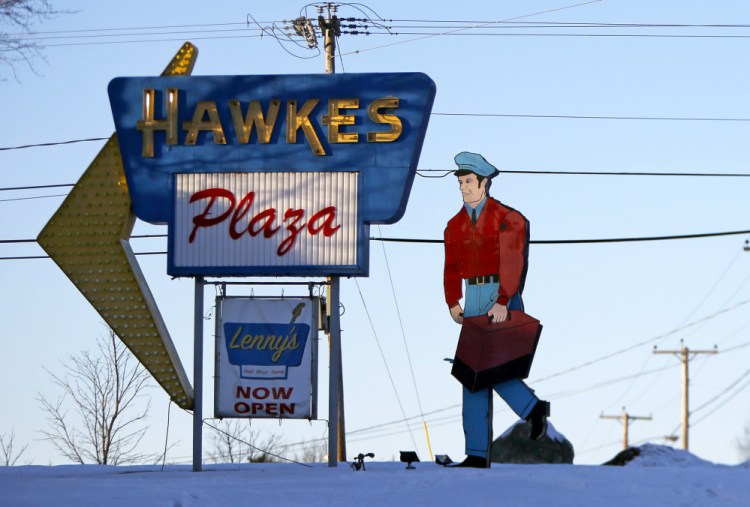When Bill Umbel was a teenager, he used to ride his bike from South Portland to look at the sound equipment sold at Hawkes Plaza on Route 302 in Westbrook.
Back then, the 13-foot-tall TV repairman would glow with neon lights and swing the toolbox in his hand.
“I remember just looking at all the stuff and seeing the sign,” Umbel said. “Not realizing, fast-forwarding almost 40 years, that I would own the thing.”
The sign was turned off in 1989, and Umbel bought the building in 2005. He has restored the 1960s-era sign, and now the Maine Historic Preservation Commission has deemed it eligible for the National Register of Historic Places.
With the Westbrook Historical Society and Greater Portland Landmarks, Umbel said he will pursue that designation for the iconic figure.
“People are thrilled part of their childhood, something they grew up with, is up and running,” he said.
The sign’s advocates say a place on the register could lead to grants for its maintenance. It could also prevent the sign from being moved to make way for a roundabout.
The state has considered that option for improving safety at the intersection of Route 302 with Duck Pond and Hardy roads in Westbrook, but the idea has not been well received by some.
Mike Sanphy, the newly elected mayor in Westbrook and president of the Westbrook Historical Society, said the sign would need to move 20 feet if the roundabout is built. Along with Greater Portland Landmarks, the historical society applied for the entire neighborhood to be designated a historic district, in part hoping to block the proposed roundabout.
Sanphy said the state recently denied that broader application, but told the groups the sign itself is eligible for the National Register of Historic Places.
“It’s quite a feat of engineering for those days,” Sanphy aid. “It was the cat’s meow of signs. It’s certainly a landmark.”
Maine musician Al Hawkes built the repairman in 1962 outside his TV repair shop and his recording studio. Travelers called it the “Giant Walking Serviceman” or the “Walking Man,” but the arm stopped swinging in 1989 when the Maine Department of Transportation prohibited moving roadside signs as a distraction to drivers.
While various businesses have operated there, Umbel opened a pub and music venue called Lenny’s in February. He repainted and repaired the sign, including updating the electrical system for 385 light bulbs. He considered the iconic figure as “part of our marketing.”
“I definitely recognize the importance of the sign over the years, ” he said. “We’ve taken care of it and maintained it, and now we use it every night.”
He said he wants to ensure the sign’s survival for years to come – and a place on the national register could help.
“It gets expensive working on that thing,” Umbel said. “It might make it easier on myself and the sign and the business.”
Neither the Maine Historic Preservation Commission nor Greater Portland Landmarks could not be reached Friday for comment.
“Greater Portland Landmarks worked with the Westbrook Historical Society and neighbors to gain recognition for the sign now threatened by a Maine Department of Transportation proposal for a roundabout at Duck Pond Corner,” the organization wrote in a blog post. “The determination by the state of the sign’s significance is an important step to preserving the sign for drivers to enjoy as they pass by for years to come.”
Send questions/comments to the editors.




Success. Please wait for the page to reload. If the page does not reload within 5 seconds, please refresh the page.
Enter your email and password to access comments.
Hi, to comment on stories you must . This profile is in addition to your subscription and website login.
Already have a commenting profile? .
Invalid username/password.
Please check your email to confirm and complete your registration.
Only subscribers are eligible to post comments. Please subscribe or login first for digital access. Here’s why.
Use the form below to reset your password. When you've submitted your account email, we will send an email with a reset code.